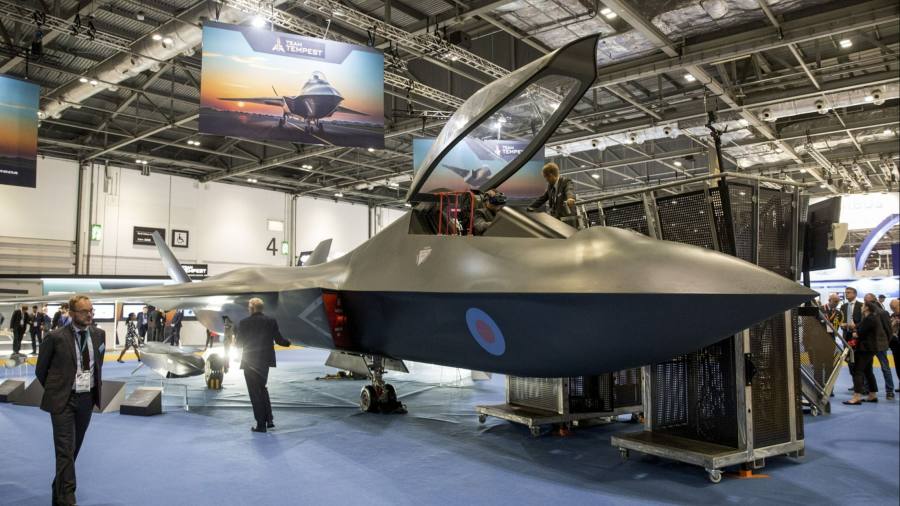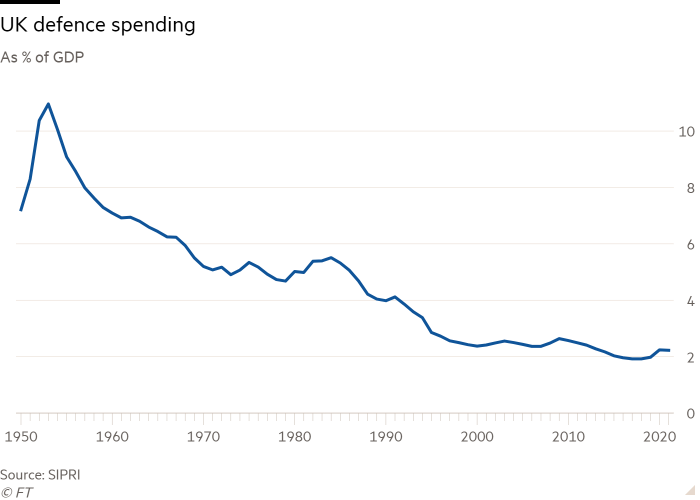
This article is an on-site version of The Lex Newsletter. Sign up here to get the complete newsletter sent straight to your inbox every Wednesday and Friday
Dear reader,
The new cold war between the west and east has particular resonance in the UK. Older Britons reflexively hark back to the second world war when discussing the war in Ukraine or China’s aggression towards Taiwan. Any concession to authoritarians is likely to be lambasted as “appeasement”.
Critics inevitably applied it this week to Prime Minister Rishi Sunak’s attitude towards China. He preferred the self-contradictory formula “robust pragmatism”.
There is plenty of support in the UK for higher defence spending among those who believe that if you want peace, you should prepare for war. Winston Churchill, a proponent of the 1930s rearmament and the second world war prime minister, remains a national hero. An affectionate likeness of him as a celestial being even adorns the clock on the side of the FT headquarters where I work.
A recent description of the British army as “only big enough to tootle around at home” by defence secretary Ben Wallace does not inspire confidence. With about 72,000 soldiers, the army is at its smallest size since the Napoleonic wars. But more boots to put on the ground — and soldiers to wear them — look like a low priority despite a global pivot to a more conventional doctrine of defence.
Wallace’s warning came as chancellor Jeremy Hunt paused plans to increase defence spending to as much as 3 per cent of national output by 2030.
That makes it harder for Britain to become more self-sufficient in armaments. The US has supplied three-quarters of UK arms imports over the past decade. The largest contract remains the supply of F-35 jets. The first part of this contract is expected to cost the UK £9bn when it completes in 2026.
The soaring dollar has sharpened the appetite of the UK Ministry of Defence for higher indigenous weapons capacity. Increased armaments costs are harder to tolerate when the bulk of jobs and taxes they generate are headed abroad. US reluctance to share weapons source code is a further issue.
This all bodes well for Tempest, the joint British-Italian-Japanese sixth-generation fighter. If the programme goes ahead, the UK’s key prime contractor BAE Systems will be heavily involved as would Leonardo of Italy, which owns large parts of the UK’s defence electronics industry.
Defence spending can be expected to rise across Europe with a larger share set to land at the feet of domestic manufacturers. In the UK spending has hovered around the 2 per cent mark for the past decade. At the end of the cold war in the early 1990s it was close to 4 per cent.

A small boost would make a big difference. UK procurement accounts for £17bn of a total defence budget of £42bn. An increase in defence spending to 2.5 per cent would push the equipment budget up by two-thirds assuming other spending remained constant, says Sash Tusa of consultancy Agency Partners.
Wallace would struggle to bring the army up to fighting strength quickly, even if money is available. A service career is unattractive to most young people. And it takes years of training to bring new recruits up to speed.
One solution is to outsource supply and support roles to free up current personnel. That would benefit Babcock, a contractor that has been out of favour since a short seller raid a few years ago. The business specialises in site management and training.
The outlook for the whole UK defence sector is positive. This reflects higher spending in other countries and western support for Ukraine. Consensus earnings estimates for the UK’s remaining listed companies for the next 12 months have risen 17 per cent since the start of the year. After several years in the doldrums the sector has re-rated to a multiple of 13 times, in line with the 10-year average.
Industry behemoth BAE now trades at a premium of 15 times earnings. The company’s earnings per share will grow at a 10 per cent CAGR through to 2025, thinks Agency Partners.
Restocking of supplies sent to Ukraine is an important part of the outlook, says Tusa. New orders for depleted kit have yet to start coming in. This is one reason the rally in defence shares began to fizzle out over the summer.
Bureaucratic friction is the reason. But the conventional war in Ukraine has reminded the generals of lessons they learnt during preparations for a war with the Soviet Union. For example, an artillery piece must fire between 100 and 200 rounds per gun daily to be effective in battle. That is equivalent to three to six months of existing UK production simply to supply 100 guns in the field for a day.
Conventional warfare is in part a competition to manufacture weapons and projectiles. That penny is slowly dropping in the minds of politicians. The British defence sector, out of favour through the years of asymmetric threats, should benefit accordingly.
Stay safe in a world that is growing more dangerous.
Andrew Whiffin
Lex Writer
If you would like to receive regular Lex updates, do add us to your FT Digest, and you will get an instant email alert every time we publish. You can also see every Lex column via the webpage
Recommended newsletters for you
Cryptofinance — Scott Chipolina filters out the noise of the global cryptocurrency industry. Sign up here
Free Lunch — Your guide to the global economic policy debate. Sign up here